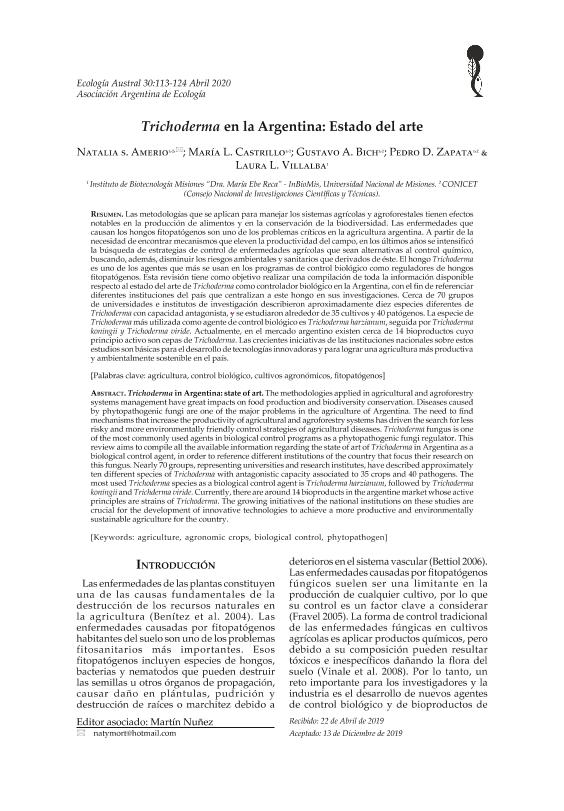Mostrar el registro sencillo del ítem
dc.contributor.author
Amerio, Natalia Soledad

dc.contributor.author
Castrillo, María Lorena

dc.contributor.author
Bich, Gustavo Angel

dc.contributor.author
Zapata, Pedro Dario

dc.contributor.author
Villalba, Laura L.
dc.date.available
2021-05-11T11:40:58Z
dc.date.issued
2020-04
dc.identifier.citation
Amerio, Natalia Soledad; Castrillo, María Lorena; Bich, Gustavo Angel; Zapata, Pedro Dario; Villalba, Laura L.; Trichoderma in Argentina: Estado del arte; Asociación Argentina de Ecología; Ecología Austral; 30; 1; 4-2020; 113-124
dc.identifier.issn
0327-5477
dc.identifier.uri
http://hdl.handle.net/11336/131788
dc.description.abstract
Las metodologías que se aplican para manejar los sistemas agrícolas y agroforestales tienen efectos notables en la producción de alimentos y en la conservación de la biodiversidad. Las enfermedades que causan los hongos fitopatógenos son uno de los problemas críticos en la agricultura argentina. A partir de la necesidad de encontrar mecanismos que eleven la productividad del campo, en los últimos años se intensificó la búsqueda de estrategias de control de enfermedades agrícolas que sean alternativas al control químico, buscando, además, disminuir los riesgos ambientales y sanitarios que derivados de éste. El hongo Trichoderma es uno de los agentes que más se usan en los programas de control biológico como reguladores de hongos fitopatógenos. Esta revisión tiene como objetivo realizar una compilación de toda la información disponible respecto al estado del arte de Trichoderma como controlador biológico en la Argentina, con el fin de referenciar diferentes instituciones del país que centralizan a este hongo en sus investigaciones. Cerca de 70 grupos de universidades e institutos de investigación describieron aproximadamente diez especies diferentes de Trichoderma con capacidad antagonista, y se estudiaron alrededor de 35 cultivos y 40 patógenos. La especie de Trichoderma más utilizada como agente de control biológico es Trichoderma harzianum, seguida por Trichoderma koningii y Trichoderma viride. Actualmente, en el mercado argentino existen cerca de 14 bioproductos cuyo principio activo son cepas de Trichoderma. Las crecientes iniciativas de las instituciones nacionales sobre estos estudios son básicas para el desarrollo de tecnologías innovadoras y para lograr una agricultura más productiva y ambientalmente sostenible en el país.
dc.description.abstract
The methodologies applied in agricultural and agroforestry systems management have great impacts on food production and biodiversity conservation. Diseases caused by phytopathogenic fungi are one of the major problems in the agriculture of Argentina. The need to find mechanisms that increase the productivity of agricultural and agroforestry systems has driven the search for less risky and more environmentally friendly control strategies of agricultural diseases. Trichoderma fungus is one of the most commonly used agents in biological control programs as a phytopathogenic fungi regulator. This review aims to compile all the available information regarding the state of art of Trichoderma in Argentina as a biological control agent, in order to reference different institutions of the country that focus their research on this fungus. Nearly 70 groups, representing universities and research institutes, have described approximately ten different species of Trichoderma with antagonistic capacity associated to 35 crops and 40 pathogens. The most used Trichoderma species as a biological control agent is Trichoderma harzianum, followed by Trichoderma koningii and Trichderma viride. Currently, there are around 14 bioproducts in the argentine market whose active principles are strains of Trichoderma. The growing initiatives of the national institutions on these studies are crucial for the development of innovative technologies to achieve a more productive and environmentally sustainable agriculture for the country.
dc.format
application/pdf
dc.language.iso
spa
dc.publisher
Asociación Argentina de Ecología

dc.rights
info:eu-repo/semantics/openAccess
dc.rights.uri
https://creativecommons.org/licenses/by-nc-sa/2.5/ar/
dc.subject
AGRICULTURE
dc.subject
AGRONOMIC CROPS
dc.subject
BIOLOGICAL CONTROL
dc.subject
PHYTOPATHOGEN
dc.subject.classification
Micología

dc.subject.classification
Ciencias Biológicas

dc.subject.classification
CIENCIAS NATURALES Y EXACTAS

dc.title
Trichoderma in Argentina: Estado del arte
dc.title
Trichoderma in Argentina: State of art
dc.type
info:eu-repo/semantics/article
dc.type
info:ar-repo/semantics/artículo
dc.type
info:eu-repo/semantics/publishedVersion
dc.date.updated
2021-04-28T20:04:19Z
dc.journal.volume
30
dc.journal.number
1
dc.journal.pagination
113-124
dc.journal.pais
Argentina

dc.description.fil
Fil: Amerio, Natalia Soledad. Universidad Nacional de Misiones; Argentina. Consejo Nacional de Investigaciones Científicas y Técnicas. Centro Científico Tecnológico Conicet - Nordeste; Argentina
dc.description.fil
Fil: Castrillo, María Lorena. Universidad Nacional de Misiones; Argentina. Consejo Nacional de Investigaciones Científicas y Técnicas. Centro Científico Tecnológico Conicet - Nordeste; Argentina
dc.description.fil
Fil: Bich, Gustavo Angel. Consejo Nacional de Investigaciones Científicas y Técnicas. Centro Científico Tecnológico Conicet - Nordeste; Argentina. Universidad Nacional de Misiones; Argentina
dc.description.fil
Fil: Zapata, Pedro Dario. Universidad Nacional de Misiones; Argentina. Consejo Nacional de Investigaciones Científicas y Técnicas. Centro Científico Tecnológico Conicet - Nordeste; Argentina
dc.description.fil
Fil: Villalba, Laura L.. Universidad Nacional de Misiones; Argentina
dc.journal.title
Ecología Austral

dc.relation.alternativeid
info:eu-repo/semantics/altIdentifier/doi/http://dx.doi.org/10.25260/EA.20.30.1.0.945
dc.relation.alternativeid
info:eu-repo/semantics/altIdentifier/url/http://ojs.ecologiaaustral.com.ar/index.php/Ecologia_Austral/article/view/945
Archivos asociados
